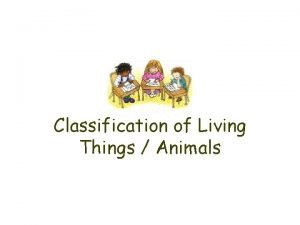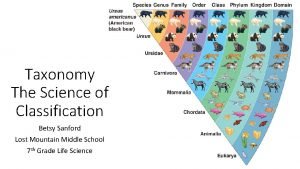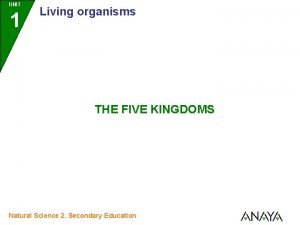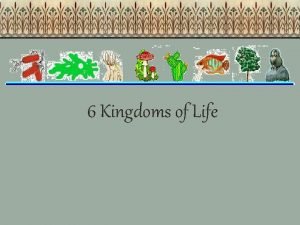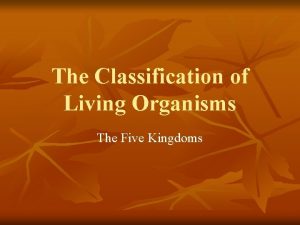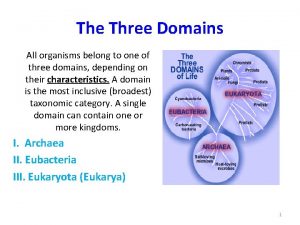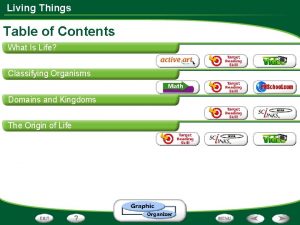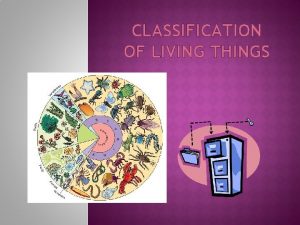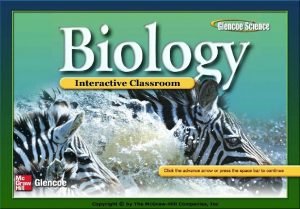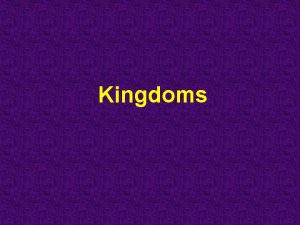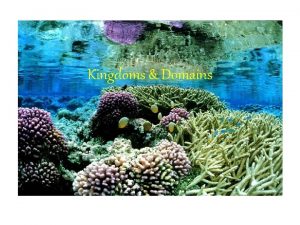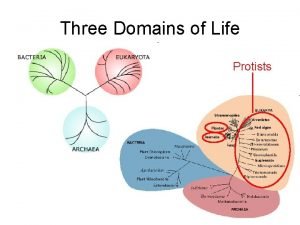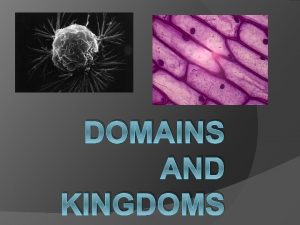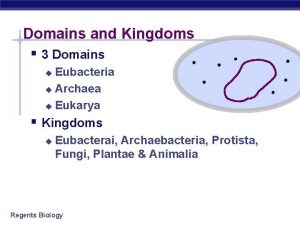Classification of Living Things Domains Kingdoms Three Domain



















- Slides: 19

Classification of Living Things Domains & Kingdoms

Three Domain System n Living things fall into three broad groups called domains. n n n Domain Archaea (archaebacteria) Domain Bacteria (eubacteria) Domain Eukarya (eukaryotes)-true nuclei with linear chromosomes and membrane—bound organelles. n This Includes Protista, Plantae, Fungi, and Animalia.

Six-Kingdom System

KINGDOM: ARCHAEBACTERIA n n n Modern Archaebacteria MAY BE Directly descended from and very similar to the First Organisms on Earth. They Are UNICELLULAR PROKARYOTES with distinctive Cell Membranes as well as Biochemical and Genetic Properties that differ from ALL other kinds of life. Some are autotrophic, producing food by chemosynthesis. Includes Chemosynthetic Bacteria Most are heterotrophic. Many Archaebacteria live in harsh environments such as Sulfurous Hot Springs, very salty lakes, and in anaerobic environments, such as the intestines of mammals.

KINGDOM EUBACTERIA n n n They are UNICELLULAR PROKARYOTES. Most of the Bacteria (Germs) that affect your life are members of the Kingdom Eubacteria are both autotrophic and heterotrophic. Includes the disease-causing bacteria such as tooth decay or food poisoning. The Combined Kingdoms, Archaebacteria and Eubacteria include the greatest number of living things on Earth. ALL OF THE PROKARYOTES ARE IN THESE TWO KINGDOMS. Both reproduce by binary fission, but they do have some ways to recombine genes, allowing evolution to occur. E. coli Staphylococcus

KINGDOM PROTISTA n n n These organisms are placed here more because of What They Are Not than What They Are. Kingdom Protista contains all eukaryotes that are NOT Plants, Animal, or Fungi, more than 50, 000 species in all. Kingdom Protista includes unicellular and a few simple multicellular EUKARYOTES. Eukaryotic cells have nuclei and organelles that are surrounded by membranes. The cells of multicellular protists are not specialized to perform specific functions in the organisms. Includes Euglena and Amoeba Euglena

KINGDOM FUNGI n n n Fungi are eukaryotes, and most are multicellular. The cells of fungi have cell walls that contain a material called chitin. These organisms are heterotrophic and obtain their nutrients by releasing digestive enzymes into a food source. They absorb their food after it has been digested by the enzymes. Fungi act either as decomposers or as parasites in nature. Kingdom Fungi includes molds, mildews, mushrooms, and yeast. mushroom

KINGDOM PLANTAE n n Plants are eukaryotes, all are multicellular and carry out photosynthesis. (They are autotrophs. ) The cells of plants have cell walls, that contain the polysaccharide cellulose. Plant cells are specialized for different functions, such as photosynthesis, the transport of materials, and support. Kingdom Plantae includes mosses, ferns, cone-bearing plants (gymnosperms), and flowering plants (angiosperms). Flowering plant (Poinsettia) fern

KINGDOM ANIMALIA n n n Animals are multicellular, all are eukaryotes and heterotrophs. Animal cells have NO CELL WALLS. Most members of the Animal Kingdom can move from place to place. (motile) Some are permanently attached to surfaces such as sponges and elephant barnacles. (sessile) Fish, Birds, Reptiles, Amphibians, and Mammals-including humans belong to the Kingdom Animalia. This Kingdom also includes sponges, jellyfish, worms, sea stars, and jellyfish insects.

II. C. 3. c. Justify why many scientists group viruses in a category separate from living things. n n n Viruses have no nucleus, cytoplasm, organelles, or cell membrane, so can not carry out cellular functions. Only able to replicate by infecting cells and using the organelles and enzymes within very small, size ranges form 20 nm to 250 nm (size of small bacteria) Consists of two parts: a nucleic acid and a protein coat called a capsid Nucleic acid may be DNA or RNA but not both Some viruses have a membrane-like structure outside the capsid called an envelope

Examples of Viruses Flu virus HIV virus

Examples of Viruses Tobacco mosaic virus Polio virus bacteriophage

Bacteriophage attacking E. coli

How a Virus Invades a Cell a) attachment of virus to host cell b) injection of viral DNA c) Integration of the viral DNA into host genome, and d) Multiplication of the host cell with the viral DNA. Lysogenic cycle of a temperate bacteriophage

HIV: a Retro Virus a) b) c) d) e) HIV attaches to the cell surface Virus core enters cell and its RNA is converted to DNA (reverse transcription) Viral DNA enters nucleus and combines with host cell DNA RNA copies of virus are made (viral assembly) The assembled viral particles leave the cell through lysis or budding.

HIV Invading a White Blood Cell

Viral Diseases

Herpes

Videos n n n Crash Course: Fungi https: //www. youtube. com/watch? v=m 4 DUZhn. No 4 s Fungus Cannon https: //www. youtube. com/watch? v=T 8 OAmc. Unm 4 g 5 Weird Ways Plants Can Eat Animals https: //www. youtube. com/watch? v=6 j 8 IFHa. HYFY Top 10 Weirdest Animals https: //www. youtube. com/watch? v=7 MLWHGRnqf. I Animal vs Plant Cells https: //www. youtube. com/watch? v=20 Ise. Njb. Ip. U Animal Characteristics https: //www. youtube. com/watch? v=Ump. TARZKyvc
 What are the three domains and six kingdoms?
What are the three domains and six kingdoms? 6 kingdoms
6 kingdoms 6 kingdom classification
6 kingdom classification Classification study guide answer key
Classification study guide answer key What are the 5 kingdoms of living organisms
What are the 5 kingdoms of living organisms Archaebacteria vs eubacteria
Archaebacteria vs eubacteria 3 domains and 6 kingdoms chart
3 domains and 6 kingdoms chart Five kingdoms of living things
Five kingdoms of living things 5 kingdoms
5 kingdoms Three domains
Three domains Pyramid hesd
Pyramid hesd What is the smallest living unit of life
What is the smallest living unit of life Sample classification of organisms
Sample classification of organisms Linnaeus
Linnaeus A genus is subdivided into smaller groups called
A genus is subdivided into smaller groups called Domain of living things
Domain of living things Sensitivity in life processes
Sensitivity in life processes Domain bacteria kingdoms
Domain bacteria kingdoms Chapter 17 section 3 domains and kingdoms answer key
Chapter 17 section 3 domains and kingdoms answer key Organizing life's diversity section 3 domains and kingdoms
Organizing life's diversity section 3 domains and kingdoms


